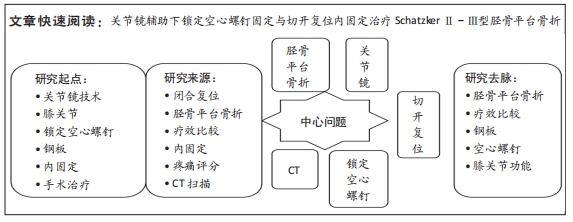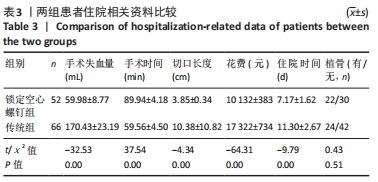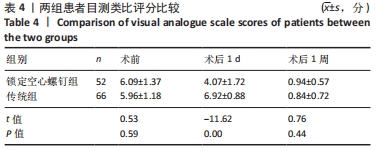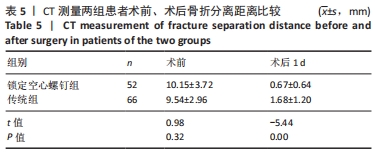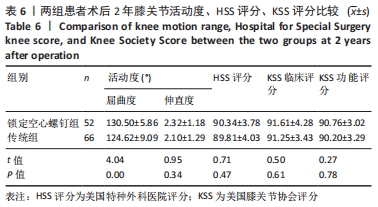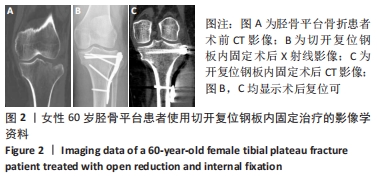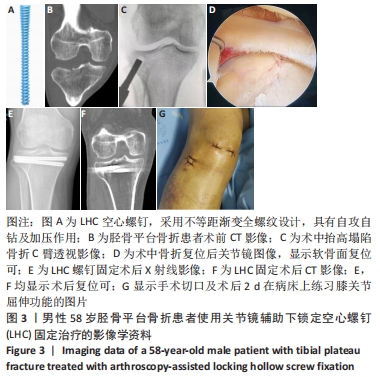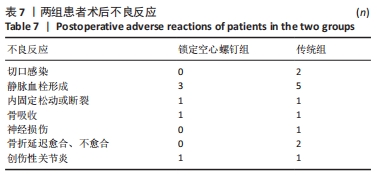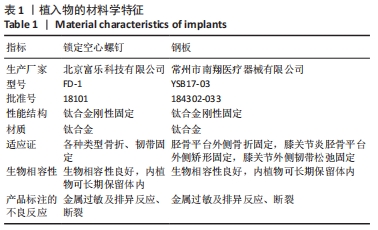[1] CUZZOCREA F, JANNELLI E, IVONE A, et al. Arthroscopic-Guided Balloon Tibioplasty in Schatzker III Tibial Plateau Fracture. Joints. 2018;6(4): 220-227.
[2] SINHA, A, MAFFULLI, N. Balloon tibioplasty for tibial plateau fractures. Surgeon. 2021;19(5):297-309.
[3] ALVAREZ A, YOUN GM, REMIGIO VAN GOGH AM, et al. Tibial Plateau With Arthroscopic Reduction-Internal Fixation. Arthrosc Tech. 2020; 9(2):e213-e216.
[4] 徐秉智, 樊国平, 崔玉娇,等. 一种LHC无头空心加压螺钉, CN206687761U[P]. 2017.
[5] MARSH JL, SLONGO TF, AGEL J, et al. Fracture and dislocation classification compendium - 2007: Orthopaedic Trauma Association classification, database and outcomes committee. J Orthop Trauma. 2007;21(10 Suppl):S1-133.
[6] GREIMEL F, WEBER M, RENKAWITZ T, et al. Minimally invasive treatment of tibial plateau depression fractures using balloon tibioplasty: Clinical outcome and absorption of bioabsorbable calcium phosphate cement.J Orthop Surg (Hong Kong). 2020;28(1):2309499020908721.
[7] SEVENCAN A, SENOL MS, MISIR A, et al. Comparison of cannulated lag screws and lateral locking plate in the treatment of Schatzker type II tibial plateau fractures.Jt Dis Relat Surg. 2020;31(1):130-136.
[8] LOWE DT, MILONE MT, GONZALEZ LJ, et al. Repair of Tibial Plateau Fracture (Schatzker II). JBJS Essent Surg Tech. 2019;9(3):e25.
[9] SAREEN A, LAL H, KAREEM SA. Innovative Use of Posterior Vertebral Wall Impactor in Tibial Plateau Depressed Fractures. Indian J Orthop. 2020;54(Suppl 2):336-342.
[10] ELSOE R, LARSEN P. Tibial plateau fractures are associated with a long-term increased risk of mortality: a matched cohort study of 7950 patients. Arch Orthop Trauma Surg. 2020;140(11):1705-1711.
[11] GAVASKAR AS, GOPALAN H, TUMMALA NC, et al. The extended posterolateral approach for split depression lateral tibial plateau fractures extending into the posterior column: 2 years follow up results of a prospective study. Injury. 2016;47(7):1497-1500.
[12] OCHEN Y, PEEK J, MCTAGUE MF, et al. Long-term outcomes after open reduction and internal fixation of bicondylar tibial plateau fractures. Injury. 2020;51(4):1097-1102.
[13] HU S CHEN S, CHANG S, et al. Treatment of Isolated Posterolateral Tibial Plateau Fracture with a Horizontal Belt Plate through the Anterolateral Supra-Fibular-Head Approach. Biomed Res Int. 2020; 2020:4186712.
[14] VENDEUVRE T, GAYET LE. Percutaneous treatment of tibial plateau fractures. Orthop Traumatol Surg Res. 2021;107(1S):102753.
[15] WANG JQ, JIANG BJ, GUO WJ, et al. Arthroscopic-assisted balloon tibioplasty versus open reduction internal fixation (ORIF) for treatment of Schatzker II-IV tibial plateau fractures: study protocol of a randomised controlled trial. BMJ Open. 2018;8(8):e021667.
[16] 翟生,黄涛.关节镜辅助与切开复位钢板内固定治疗Schatzker Ⅰ-Ⅴ型胫骨平台骨折的比较[J].中国微创外科杂志,2020,20(10): 901-905.
[17] 陈刚,郑文标,陈滔,黄杨,等.关节镜下与切开复位内固定手术治疗胫骨平台Schatzker Ⅲ型骨折血清炎症因子变化对预后的影响[J].中国骨伤,2020,33(3):252-256.
[18] 余金胜,方文广,冼树强.关节镜辅助下治疗复杂胫骨平台骨折的疗效分析[J].中国内镜杂志,2021,27(3):59-65.
[19] 魏文强,顾峥嵘,曹烈虎,等.关节镜下微创治疗18例胫骨平台骨折合并前交叉韧带胫骨止点撕脱骨折的疗效观察[J].中国内镜杂志,2021,27(5):84-88.
[20] 史然利,王艳丽,王涛,等.膝关节镜辅助内固定术与后外侧入路治疗后外侧胫骨平台骨折[J].西部医学,2021,33(1):74-78,83.
[21] 徐文铭,余阗,蒋顺琬,等.关节镜下微创内固定治疗Schatzker Ⅲ型胫骨平台骨折的效果及对炎症因子的影响[J].实用骨科杂志, 2020,26(11):982-986.
[22] WANG Z, ZHENG B, JIN Y, et al. Arthroscopy-assisted surgery: The management of posterolateral tibial plateau depression fracture accompanying ligament injury: A case series and review of the literature. J Orthop Surg (Hong Kong). 2020;28(1):2309499019891208.
[23] ROBERTSON GAJ, WONG SJ, WOOD AM. Return to sport following tibial plateau fractures: A systematic review. World J Orthop.2017;8:574-587.
[24] SAREEN A, LAL H, KAREEM SA. Innovative Use of Posterior Vertebral Wall Impactor in Tibial Plateau Depressed Fractures. Indian J Orthop. 2020;54(Suppl 2):336-342.
[25] MAUFFREY C, ROBERTS G, CUELLAR DO, et al. Balloon tibioplasty: pearls and pitfalls. J Knee Surg. 2014;27(1):31-37.
[26] YANG Y, ZHOU X, JI H, et al. A novel arthroscopically assisted reduction technique for three patterns of posterolateral tibial plateau fractures. J Orthop Surg Res. 2020;15(1):376.
[27] PETERSON LC, KIM SE. Minimally invasive fixation of a lateral tibial plateau fracture in a dog. J Small Anim Pract. 2021;62(2):161.
[28] BOISRENOULT P, BRICTEUX S, BEAUFILS P, et al. [Screws versus screw-plate fixation of type 2 Schatzker fractures of the lateral tibial plateau. Cadaver biomechanical study. Arthroscopy French Society]. Rev Chir Orthop Reparatrice Appar Mot. 2000;86(7):707-711.
[29] GIORDANO V, BELANGERO WD, SÁ BA, et al. Plate-screw and screw-washer stability in a Schatzker type-I lateral tibial plateau fracture: a comparative biomechanical study. Rev Col Bras Cir. 2020;47:e20202546.
[30] VAN DREUMEL RL, VAN WUNNIK BP, JANSSEN L, et al. Mid- to long-term functional outcome after open reduction and internal fixation of tibial plateau fractures. Injury. 2015;46(8):1608-1612.
[31] SAMENT R, MAYANGER JC, TRIPATHY SK, et al. Closed reduction and percutaneous screw fixation for tibial plateau fractures. J Orthop Surg (Hong Kong). 2012;20(1):37-41.
[32] TELIS AL, TUCKER DW, COMPTON E, et al. Treatment of tibial plateau fractures with a novel fenestrated screw system for delivery of bone graft substitute. Eur J Orthop Surg Traumatol. 2021;31(7):1321-1327.
[32] WANG Z, ZHU Y, DENG X, et al. Structural Bicortical Autologous Iliac Crest Bone Graft Combined with the Tunnel Bone Tamping Method for the Depressed Tibial Plateau Fractures. Biomed Res Int. 2021; 2021:1249734.
[34] ROLVIEN T, BARVENCIK F, KLATTE TO, et al. ß-TCP bone substitutes in tibial plateau depression fractures. Knee. 2017;24(5):1138-1145.
[35] LIANG J, ZHANG Q, LIU P, et al. Arthroscopic-assisted inflatable bone tamp reduction for treatment of posterolateral tibial plateau fractures. Injury. 2018;49(11):2061-2067.
[36] GOFF T, KANAKARIS NK, GIANNOUDIS PV. Use of bone graft substitutes in the management of tibial plateau fractures. Injury. 2013;44 Suppl 1: S86-94.
[37] RUAN W, LI M, GUO Q, et al. Gastrocnemius muscle flap with vancomycin/gentamicin-calcium sulfate and autogenous iliac bone graft for the phase I treatment of localized osteomyelitis after tibial plateau fracture surgery. J Orthop Surg Res. 2021;16(1):341.
[38] HARE KB, BRAND E, BLOCH T. Highly impacted bone allograft may allow immediate weight bearing in tibial plateau fractures: A case report. Trauma Case Rep. 2020;29:100331.
[39] GANDAPUR HK, AMIN MS. Complex tibial plateau fractures: Clinical and radiological outcome following plate osteosynthesis.J Pak Med Assoc. 2021;71(Suppl 5):S35-S41.
[40] ONG JC, KENNEDY MT, MITRA A, et al. Fixation of tibial plateau fractures with synthetic bone graft versus natural bone graft: a comparison study. Ir J Med Sci. 2012;181(2):247-252.
[41] HOFMANN A, GORBULEV S, GUEHRING T, et al. Autologous Iliac Bone Graft Compared with Biphasic Hydroxyapatite and Calcium Sulfate Cement for the Treatment of Bone Defects in Tibial Plateau Fractures: A Prospective, Randomized, Open-Label, Multicenter Study. J Bone Joint Surg Am. 2020;102(3):179-193.
[42] KRAUSE M, ALM L, BERNINGER M, et al. Bone metabolism is a key factor for clinical outcome of tibial plateau fractures. Eur J Trauma Emerg Surg. 2020;46(6):1227-1237.
[43] 乐礼祥,丁健,顾本进,等.切开复位内固定术治疗闭合性胫骨平台骨折深部感染的危险因素分析[J].中国骨与关节杂志,2020, 9(12):940-943.
|
